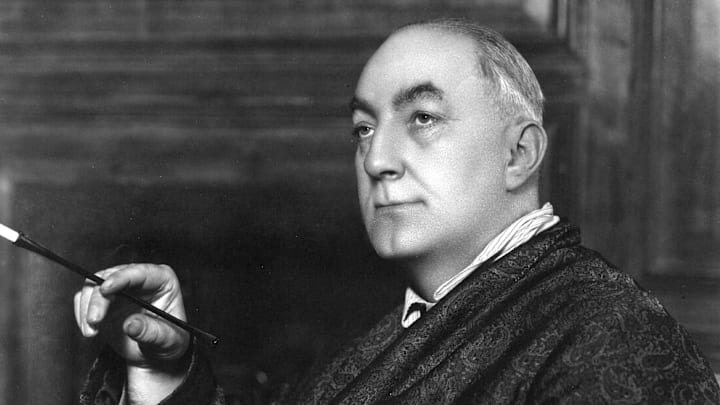Edgar Wallace had a brilliant idea, one he thought had the potential to make him a household name.
In the future, the writer, then 30, would become one of the most prolific authors of his time—he’d even be given the nickname “the King of Thrillers” and co-write the screenplay for 1933’s King Kong (his final writing project before his death in 1932). But at the beginning of the 20th century, Wallace had been primarily working as a journalist and war correspondent. He wrote fiction on the side to try to earn extra money; one of his stories, “Smithy,” had recently sold around 30,000 copies for a shilling each.
“Emboldened by this success,” he later wrote, “I sat down to turn a short story I had written, and which had been rejected by every magazine in London, into a longer one.” It became his first novel, The Four Just Men, published by the London-based Tallis Press in 1905. And rather than simply advertising his book the traditional way, Wallace had something a little more unusual in mind.
“I was determined … to make some sort of reputation as a story-writer, even if it broke me to do so,” he remembered. “It broke me all right.”
In fact, rather than earn him money, Wallace’s innovative marketing campaign for The Four Just Men nearly led to his financial destruction.
Marketing a Mystery
The titular “four just men” of Wallace’s novel are the vigilantes Leon Gonsalez, George Manfred, Poiccart, and Thery. They take it upon themselves to exact justice on people who have faced no consequences for the wrongs they’ve done.
The novel begins with the men gathering at a café in the Spanish city of Cadiz and sharing stories about the various ways in which they served their own form of justice to people who haven’t been held accountable by the law. They then decide to murder a British government minister, Sir Philip Ramon, due to his role in the passing of an unjust law that would leave people living in exile in the UK vulnerable to being extradited back to countries where they were at risk of the death penalty for opposing dictators.

The book follows their pursuit of this plan—to a point. Unlike most murder mystery novels, The Four Just Men didn’t conclude with an explanation of how the crime was committed. Instead, how the minister meets his end in a locked room was left unresolved, and the reader was invited to write in with their own guess to the solution of the mystery.
It was all part of Wallace’s grand marketing plan: He offered, from his own pocket, £500 worth of prizes (the equivalent of £53,023.35, or more than $72,000, now); the first prize, £250, (£26,511.68 or nearly $36,000 today) was a huge sum in 1905. The competition was touted on the book’s spine—between the names of the author and the publisher, it read “£500 PRIZE STORY”—and within was a detachable return slip the reader could send in if they decided to make a play for the prize.
Wallace believed the contest would encourage many more people to buy the book, and hence make money for him. He had originally wanted to the total prize money to be £1000, but was convinced to go with the lower pot by his colleagues at the Daily Mail. That was fortunate for the author, because the marketing ploy ultimately backfired—disastrously.
You Might Also Like ...
- The Strange Literary Puzzle Only Four People Have Ever Solved
- The Novel That Seemingly Predicted the Titanic Disaster
- How Washington Irving’s Clever Hoax Named the New York Knicks
Add Mental Floss as a preferred news source!
An Unmitigated Disaster
Wallace’s marketing plot blew up for two main reasons. The first was that Wallace had massively underestimated the number of readers who would accurately guess the solution to the mystery. But perhaps a bigger issue was that the wording of the competition didn’t specify a limit on the number of winners. This meant that a large number of people claimed a share of the prize money, vastly outstripping the actual £500 prize pot.

The author also spent his own money to pay for more conventional promotion for the novel, including notices in newspapers and advertising on buses, incurring a further financial loss.
“Although I sold 38,000 copies, I lost £1400!” Wallace would later write of the debacle in his autobiography. “There was, I discovered, such a thing as over-advertising.” He ended up selling the rights to future novels about the Four Just Men to pay back his debts.
A Lasting Legacy
Once the dust from The Four Just Men disaster had settled, however, Wallace continued with his writing. He eventually found lasting success, going on to write more than 170 novels (not to mention plays and film scripts) in his career. A new edition of The Four Just Men was also published in 1906—this time containing the solution to the mystery, which had turned out to be less mysterious to many readers than Wallace had hoped.
In his later works, Wallace would write a number of sequels featuring the “just men,” the last of which was published more than 20 years later, in 1928. By then, he was able to lean on his back catalogue of work as part of the promotion of the novels. He would never again try such a reckless stunt as the one that brought him to the brink of financial ruin.
